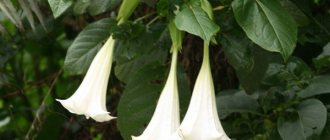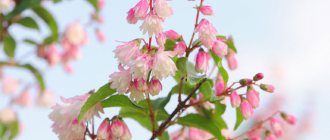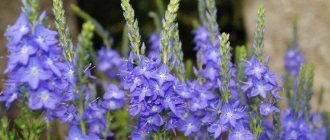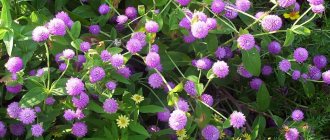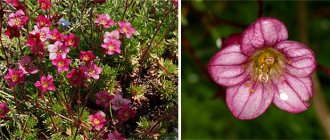The heliotrope flower is hard to miss in the garden; its soft lilac caps of inflorescences invariably attract attention, and if you come closer, you can feel a wave of a delightfully warm spicy aroma. This plant has the amazing property of unfurling its flowering clusters throughout the day, accompanying the path of the sun across the sky. In the natural environment of South America (Peru), heliotrope is a perennial, but planting in the open ground of the middle zone can only be annual due to intolerance to cold weather. However, it is quite possible to preserve the beauty of this Peruvian by taking him from the garden to a warm house and arranging him to spend the winter on the windowsill. Caring for heliotrope during wintering is not difficult - it is only important to maintain a balance of watering and ensure relative coolness.
General description with photo
Heliotrope is an ornamental perennial plant from the Borage family of bushy-herbaceous type.
In indoor conditions it can be grown for several years; in open ground, under any shelter, it dies. The leaves are dark green, wrinkled-wavy, slightly pubescent, which is why they look soft and velvety. They have a convex ovoid shape and are supported by short petioles. The flowers are painted in purple, blue, lilac, dark blue or white tones, collected in large and fairly dense corymbose inflorescences with a diameter of up to 20 cm.
In addition to their high decorative properties, they are valuable for their essential oil content, the subtle spicy smell of which is widely used in perfumery. The bushes can reach a height of just over half a meter.
Heliotrope blooms in mid-summer, flowering of ordinary species and varieties lasts about a month, new hybrid varieties can bloom until late autumn. Then the coenobium fruit ripens on the peduncle, eventually breaking up into 4 parts (erems). Each of the erems contains small seeds of the plant.
Heliotrope has varieties whose stems contain the alkaloid cynoglossin, which is poisonous to humans and animals and has a paralyzing effect on the central nervous system. Another poisonous alkaloid is contained in its seeds (lasiocarpine), but, as a rule, these species are not grown in culture.
How to care outdoors
The heliotrope plant is considered tropical, which means it should not lack sunlight. You also need to know how to water heliotrope:
- When it’s hot, the plant needs to be watered frequently and abundantly; at other times, moderate watering is sufficient.
- in order for moisture to also reach the leaves, it is recommended to spray the heliotrope with water from a spray bottle
Before the period of active flowering begins, the plant must be fed with mineral fertilizer at least twice a week. After the heliotrope begins to bloom, the procedures must be stopped.
In order not to constantly weed weeds around the plant, it is better to mulch with peat.
Popular varieties of heliotrope with photos
The plant has a huge number of botanically described and undescribed varieties, however, no more than five of them are grown in Russian gardens.
Heliotrope tree (Peruvian)
Serves as the basis for the creation of numerous varieties and hybrids. A typical representative of the species is up to 60 cm tall, blue-violet in color and forms dense, densely leafy bushes. The short-petiolate leaves are distinctly wrinkled, slightly pubescent, and ovoid in shape.
The most popular variety series of the Peruvian variety is Marin, characterized by a purple tint of dark green foliage and deep purple inflorescences. The shortest representative of the species is the Mini Marine variety, barely reaching 35 cm in height and blooming with bright blue-violet buds. Also very popular are the varieties Regal Dwarf, which is compact, and White Lady, whose flowers initially have a pinkish color, and when fully bloomed, become pure white.
The “Black Beauty” variety, with purple tassels and a delightfully delicate aroma, is slightly ahead of it in growth.
The pride of the breeders is the “Fragrant Delight” variety, which has a lavender color of varying intensities moving from the middle to the edges.
Heliotrope corymbose (corymbose)
Compared to the previous species, it has larger inflorescences and narrowed leaves. In addition, it differs from all others in its greatest height, which in some cases can reach a meter or more. The leaf blades are lance-shaped, similar to a boat. The leaves are less richly colored on top than on the bottom. It blooms in blue-blue tones; the bred hybrids are able to continue flowering until frost.
European heliotrope
Places of natural growth are the Mediterranean region and South America. The strongly branching stem grows up to 40 cm, covered with oblong foliage that has a light green-yellow color. A characteristic feature of the buds is their “curliness” due to the shape of the curled petals. Thanks to this, the inflorescences look incredibly lush and dense. Flowering continues until the end of summer.
Heliotrope Kurasavsky
Forms lush and spreading bushes of considerable height. The flowers are painted in pale blue tones, sitting on tall and strong peduncles.
Heliotrope stem-encompassing
Not the most popular among gardeners is a low-growing variety with long, wavy, pointed leaves along the edge. Blooms in rich purple color.
The name of the flower in Greek reflects its ability to turn after the sun - “helios” (sun) “plus” trope (turn).
Heliotrope care
Proper planting makes caring for the plant much easier, so it is important, first of all, to decide on the location, especially when planting in open ground. If in the future it is planned to grow heliotrope as a perennial, you should immediately take care of moving it indoors for the winter. The best solution would be to plant in a pot that is dug into the area. But the size of the root system allows it to be dug up to be transferred to a planting container.
Soil requirements
Fertility and good aeration properties are the main soil requirements for this flower. For planting in a pot, it is better to use a ready-made mixture for flower crops or seedlings. It is recommended to mix equal amounts of humus, sand and high-moor peat on the site. In any case, it is very advisable to disinfect the substrate by pouring it with a strong manganese solution or calcining it, if possible, in the oven.
Watering
A care point to which the culture is very demanding. The soil should always be permanently moistened, but within moderate limits. Drying out the substrate leads to loss of decorativeness, and its overmoistening leads to fungal diseases. When growing in summer cottages, when there is no possibility of regular, timely watering, it is worth using mulch that retains natural moisture for a long time. Mown and slightly dried grass, buckwheat husks (looks very decorative and allows you to avoid thickening the planting), sawdust, and shavings are well suited for it. Mulch will benefit plants even in rainy weather, eliminating the contact of the above-ground part with the ground.
Top dressing
You can start feeding the plant a couple of weeks after planting the seedlings in open ground, followed by a 2-week alternation of organic matter and mineral complexes. The best time for this is in the evening after watering.
Choosing a place for a flower bed
Heliotrope is a light-loving flower, so it will feel best in the most illuminated areas. Of course, it can be planted in partial shade. But due to lack of light, the shoots of the plant will become very elongated. In addition, the shrub produces fewer flower stalks, and the color of the petals will noticeably fade. But in partial shade, the buds stay on the stems longer.
As for the soil, an area with fertile, breathable soil, deep groundwater and a neutral reaction would be ideal for heliotrope. Moreover, it is advisable to plant the flower on a hill, because it categorically does not tolerate lowland.
If the soil on the site is too heavy, be sure to “lighten” the soil before planting. To do this, add compost, humus, peat or sand to the ground. Otherwise, the flower will develop poorly, which will negatively affect its decorative effect.
Wintering heliotrope
The climate of temperate latitudes leaves no hope of preserving the flower in open ground. To preserve the plant, you need to carefully dig it up and plant it in a pot, the size of which allows you to preserve the root system as much as possible. This should be done shortly before the first frost, but it is better to wait until the budding period ends if this is a long-flowering variety. The temperature at home should be low, optimally within +16...+18C, but the lighting requirements are almost summer-like. Therefore, it is advisable to place the flower in a place where there is additional lighting in the evening and morning. Throughout the wintering period, you should follow the usual watering regime without drying out the roots or overmoistening them.
Heliotrope overwintered at home can serve as an excellent source of planting material for vegetative propagation next year.
Forum, reviews
A study of the experience of gardening enthusiasts shows that growing Heliotropium is accessible to anyone, no matter if you have similar experience. The main thing is to approach the process competently and follow the necessary recommendations. Reviews presented on the Internet indicate that this shrub is very popular today. And this is not surprising, because its bright “appearance” can decorate any window sill or garden plot. And besides the beauty, the owners will also be pleased with the pleasant, unobtrusive aroma.
Growing heliotrope from seeds
This method does not guarantee results, since the seeds may simply not ripen in an insufficiently warm climate. The main problems of heliotropes grown from low-quality seeds are late flowering, uneven height of bushes, and small inflorescences. In addition, in hybrids they may not produce parental characteristics. But, of course, you can try your luck.
How to collect seeds?
Seed material should be collected only after the plant has not just blossomed and withered, but has dried out and completely turned black. Only in this case is there a chance to get ripened seeds. The cut inflorescences are peeled onto paper, dried and stored in a paper bag or cardboard box.
When and how to plant?
It is best to plant heliotrope seeds for seedlings in February, the deadline is in March. The prepared disinfected substrate should be compacted using a plank. The seeds are poured on top of it and evenly distributed, after which the top layer of soil is poured and also lightly compacted. The embedment depth is 1-2 mm. The container is covered with transparent material and placed in a warm place. Shoots may appear unevenly, but after the first, the shelter must be removed. The plants do not require bright lighting; it is enough to place the seedling container in a regular bright place, this will not affect their development.
Picking
Picking with root pinching is done at the stage of two true leaves. You can immediately plant the seedlings in individual containers. After 2 weeks, it is recommended to use seedling fertilizer.
Planting in open ground
The time for planting in an open place is June; the return of frost should be completely excluded. It is advisable to choose a well-lit place. Transplantation is carried out by transshipment.
Propagation by apical cuttings
If a flower overwinters at home, it is very convenient to obtain planting material from it in the form of apical shoots. They are cut in February-March, the length of the cuttings is 4-5 cm. The lower leaves are completely removed, the upper pair is shortened by half. All existing sections are treated with ash, crushed coal or chalk, but it is best to use Kornevin powder or use another root formation stimulator. Planting is best done in large peat tablets. Care is usual, as with seedlings; transfer to open ground is carried out with the onset of consistently warm weather.
Pests and diseases
When there is an excess of moisture, especially against the backdrop of cool conditions, for example, in a rainy, cold summer, heliotrope is often affected by gray rot, as well as rust. Any of the suitable fungicides (Maxima, Diskora, Strobi, etc.) will provide first aid to the plant. The treatment must be repeated in compliance with the interval specified by the manufacturer for this product.
Of the pests, the most common uninvited guests are whiteflies, spider mites and the ubiquitous aphids. Treatment is also standard using industrial insecticides (Aktellik, Funafon, etc.).
Medicinal properties
In addition to its delicious smell, heliotrope also has some medicinal properties that are used by experienced herbalists. This is an anthelmintic effect, external burning of warts and treatment of lichen, as well as the ability to help with kidney stones. However, independent use of the plant for medicinal purposes is extremely dangerous and is categorically not recommended by doctors due to the possible content of toxic alkaloids. Thus, recently the plant in this capacity was withdrawn from sale and banned by health authorities in Germany.
Application in landscape design
The first mention of the use of Heliotropium for landscape decoration dates back to the nineteenth century. Today, the flower is also actively used for these purposes. Heliotrope harmonizes wonderfully with other low flower crops, namely petunias, begonias, and pelargoniums.
Know! These bright plants look spectacular as borders or individual flower beds.
